AMD Is 'Aggressively' Incentivizing Partners To Sell Ryzen Pro
'We're really taking steps that are new and substantial investments on the AMD side, relative to what we've done in the commercial business historically, to go grow this market for us,' AMD's Matthew Unangst says of the chipmaker's new enterprise-level laptop processors.

AMD Commercial Client Director Wants Big Wins For Partners
AMD said it is "aggressively" incentivizing channel partners to sell the company's latest Ryzen Pro processors that are bringing performance, high battery life and enterprise-level management features to dozens of ultra-thin business laptops this year.
The Santa Clara, Calif.-based company announced the new Ryzen Pro 4000 series last week, promising higher performance than Intel's 10th-generation Core U-series mobile processors and enterprise features that are competitive with the Intel vPro platform.
[Related: 10 Business Laptops That Use AMD's New Ryzen 4000 CPUs]
In an interview with CRN, Matthew Unangst, director of AMD's commercial client business, said the chipmaker is deploying a variety of resources to educate and incentivize solution providers to sell laptops using the new processors, which are based on AMD's 7-nanometer Zen 2 architecture that has helped the company gain market share in the x86 client and server processor markets.
"We're really taking steps that are new and substantial investments on the AMD side, relative to what we've done in the commercial business historically, to go grow this market for us," he said.
That includes AMD Arena, the company's new online training program that offers partners rewards for things ranging from merchandise to AMD-based laptops. The company has also ramped up direct training with partners, which will be done virtually for now due to the pandemic, according to Unangst. Then there's things like quick reference tools and marketing campaigns to target end customers.
Unangst said the company is also investing resources to ensure Ryzen Pro 4000 sales are a "win-win" scenario for AMD and its partners. He declined to provide more specifics about what kind of incentives the company is offering partners but said it's meant to be "a win for us in terms of growing the business but also wins for those partners in terms of seeing an opportunity to address their business goals."
"[It] incentivizes those partners more aggressively than what we've done in the past," he said. "And that allows us to aggressively go after growing that business in a way that's a win-win."
Unangst acknowledged that AMD hasn't had a solid track record on the commercial side in the past, but he said the company has overcome "historical concerns around AMD platforms," as demonstrated by its continued adherence to the Zen product roadmap that was established years ago and has since resulted in market momentum and big customer wins, particularly on the EPYC side.
"We're continuing to work through a long lasting perception in the market that we don't have the products that are capable," Unangst said, "but I think that absolutely, we have shown with the products that we've released over the last couple years and now coming this year that we have more than overcome some of those previous shortcomings in our product stack."
What follows is an edited transcript of CRN's interview with Unangst, who talked about the new opportunities Ryzen Pro 4000 creates for partners, how Ryzen Pro differs from Intel vPro, the company's commitment to providing a steady supply of CPU and how the company has convinced OEM partners to use AMD processors for more business laptop designs this year.
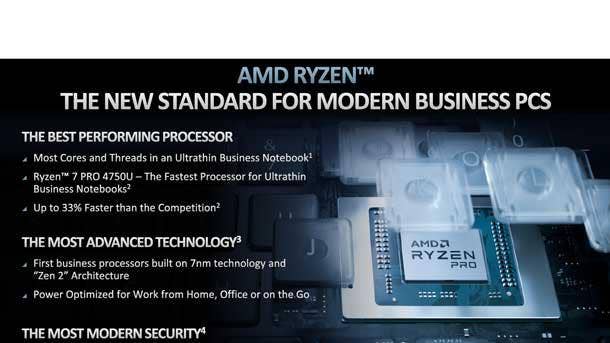
What would you say are AMD biggest priorities for Ryzen Pro this year?
The key thing we're focused on is delivering a leadership class of product for our commercial products and frankly raising the bar in terms of the performance, battery life and technology capabilities there. If you look at what we have with Ryzen Pro 4000 coming out with our products, in the first half of this year, it is substantially more advanced and more capable than anything we've ever delivered. And it really positions us in a leadership position to compete and continue to grow that business in the market.
Has the pandemic changed how AMD plans to promote Ryzen Pro this year?
The pandemic is obviously a very real situation. It's very scary for people personally, and the businesses are trying to adjust to it. What I would say is, we have actually worked very well with our OEM partners to make sure that we keep our products on track here. It has not fundamentally changed any of our launch plans.
From a standpoint of marketing, I think what we are certainly seeing is that more and more focus is being put on how people work from home, and the tools and capabilities around how people work remotely. It's yet to be seen how lasting of an impact that becomes. But for us, the timing of the products we've got coming out here is actually great because, we're confident that with the growing portfolio we have, coupled with the performance gains [as well as] the power efficiency aspect and the substantially improved battery life that we're delivering, that actually really delivers a great portfolio that is ideal for addressing either remote workers or the work-from-home environment on both the [small- to medium-sized business] and the enterprise side.
What would you say are the biggest differentiators between AMD Ryzen Pro and Intel vPro?
On a couple aspects. The first one, on terms of raw performance capabilities, the fact that we are able to pack more cores and threads into ultra-thin commercial notebook platforms certainly is a big item there. And that's really enabled through the combination of that Zen 2 architecture as well as that 7-nanometer process technology. And so you've got more computing power in the same infrastructure, which is really delivering more performance ultimately.
But the other great thing is that with the combination of 7nm, coupled with the way we designed this product, you don't have to make a decision between great performance and great battery life. We actually did step function improvements in performance, and we're going to deliver substantially better battery life than we ever have. And so I look at that key area where we're differentiating, performance and battery life. And then certainly, the introduction of our AMD Pro Technologies, which deliver that feature set, especially on our Pro class of products, that enterprises need to run their business. That is a key part of our feature set to ensure that we have the products that our enterprise customers need.
What considerations for customers factored into the design of the Ryzen Pro 4000 processors?
If you take a step back, and you look at what AMD has been driving over three to four years now, every product that we developed, we're very, very focused on performance leadership and delivering great products that can disrupt and lead the market from a performance standpoint. So there's no question that that was priority number one.
But then, especially as we looked at the commercial market in our Ryzen Pro class of products, we got very focused on making sure that we're addressing customer needs, and, frankly, areas that historically have been a weakness on AMD platforms. That's where the battery life focus came in as a top priority.
And I know I almost sound like a broken record here, but also that's where we went and invested a significant amount of resources and focused on really bolstering those AMD Pro Technologies to make sure that our products have the feature set that enterprise customers need. There's a strong consistency here between the capabilities of the product and what we have been very focused on as we've developed this product over the last couple years.
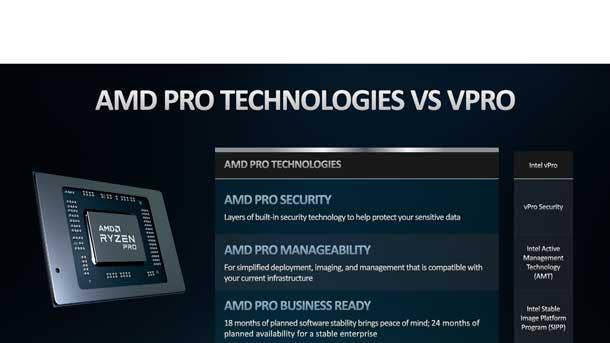
How can Ryzen Pro help with an IT organization with remote management capabilities?
I think if you look at our AMD Pro Manageability feature sets, what we deliver there is a very robust set of features so that an IT department can integrate AMD-based platforms using the same process and the same steps and the same overhead as integrating a new platform from our competition, and then deliver the toolsets for them to manage those PCs.
So whether workers are in the office or working remotely or at home, the ability for that IT department to monitor their PC fleet, push security patches, even do remote provisioning and enable employees working remotely with new platforms and get them set up — all of those capabilities are there as part of that AMD Pro Manageability. And so from an IT perspective, that's really the key thing that enables them to really integrate AMD platforms without any extra worker overhead versus our competition.
What is AMD's strategy for pushing adoption of Ryzen Pro?
The product is table stakes. It's absolutely essential that we get the product right and that we have a great product. But that's really just the starting point. And so when we look at our commercial business, delivering the right product with leadership capabilities is step one.
Now what we're doing is, we're really taking steps that are new and substantial investments on the AMD side, relative to what we've done in the commercial business historically, to go grow this market for us. So we have rolled out a new tool around training, AMD Arena. That's a key mechanism for us to go educate our partners and resellers and customers about the capabilities of the product. We're putting investments into very targeted campaigns in a way that we haven't done before.
And then, to round that out, we have put some new programs in place, in particular with our channel partners, to build out those partnerships to a level that they haven't been before.
It's about generating end user awareness and demand for our product. It's about improving and strengthening our partnerships with all of the distributors and resellers that sell our products. And then it's about continuing to strengthen that relationship with our OEM partners, so that we're working in concert as we drive this. There's no one silver bullet here — it's a big business — and we are focused on all of the pieces there to continue to take what is a great product and accelerate adoption in the market.
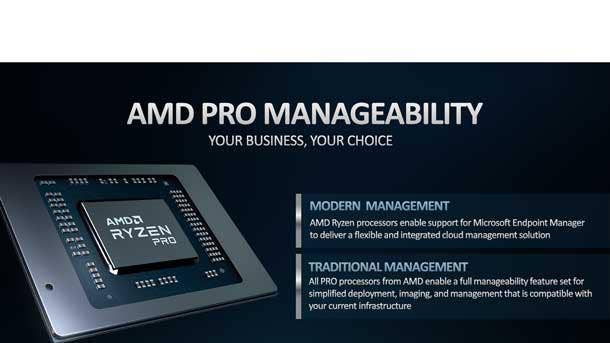
When you're talking about strengthening the relationships with channel partners, can you elaborate on that? What does that actually look like for the channel partners?
If you look at what we have done this year — and I can't I can't go into all the details on this because a lot of it's under NDA — but what we have done is deployed a number of new programs in partnership with those distributors and resellers that does a couple things.
One is, it helps drive a better, more robust set of training for the managers and sales reps inside of those partners, so that they have a better understanding of the end products, the advantages of that and are able to go sell those products, but it also incentivizes those partners more aggressively than what we've done in the past. And that allows us to aggressively go after growing that business in a way that's a win-win. A win for us in terms of growing the business but also wins for those partners in terms of seeing an opportunity to address their business goals.
For the training, is that the same as AMD Arena or is that a separate program?
To be very clear, AMD Arena is a big part of that, especially on the commercial side.
But there's additional training there, which includes going in and doing actual in-person training, supported to a large extent by AMD resources and our sales and marketing team going in and just really having a focused effort to make sure that the sales partners, their sales teams, understand our products, are able to ask questions, are able to interact with us, and just improving that engagement beyond where it's been historically.
Which channel partners do you work with on those more face-to-face trainings?
We have our sales teams that obviously have coverage of each of those distributors and resellers, especially the largest ones. And what we do there is we work directly with our sales team. We make sure that they are engaging with those folks on a daily basis.
And then what we're doing is, on top of that, we're coming in and providing these trainings. Honestly, it's nothing complicated. It's setting up time on calendars and engaging and, obviously today, that's all happening remotely, but in time that will transition as well to in person.
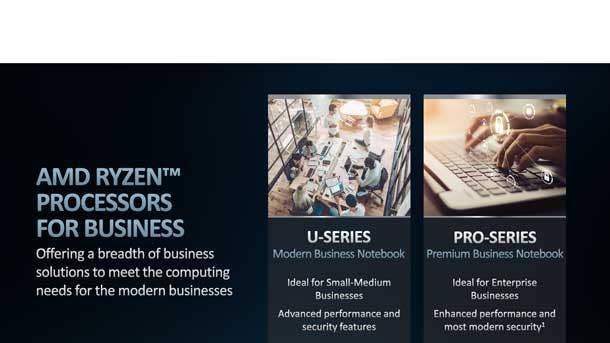
You said you're aggressively incentivizing partners. What does that mean?
I can't really elaborate on all the details there. What we're focused on is making sure that we have a structure that's a win-win between both us and our channel partners.
Beyond the face-to-face trainings and AMD Arena, are there any other tools and resources that channel partners are going to be able to use to promote and sell Ryzen Pro laptops?
The other thing that we have substantially improved, and I know this sounds almost trivial in nature, but we're really raising the bar in terms of the tools that we deliver to those sales folks, so that they have quick reference. They're able to refer back to them to understand more details about our products, answer quick questions. So that's a key part of that, something that you leave behind when you engage with those folks. And then I mentioned this earlier, but [we're] also making investments in very targeted campaigns as well, to improve our brand awareness.
One big issue for solution providers has always been profitability and how they can improve it. From AMD perspective, is there anything that AMD can do to help them improve their profitability?
Yeah, absolutely. I think No. 1, delivering superior technology is key to that and having the ability for these partners to sell products that deliver what their customers need. And then if you look at how they can sell an AMD-based platform, you've got, for the first time ever, performance leadership, you've got great battery life, you meet the needs of an enterprise customer, and then there's also an opportunity for these partners to add in services that are key to their goals and their growth as well.
So certainly, I think as we continue to grow our business and grow our brand, and continue to evolve and improve and grow our leadership positioning, I think it helps all of us, both AMD obviously, but I think it also helps those resellers, as it gives them more options to go manage their business.
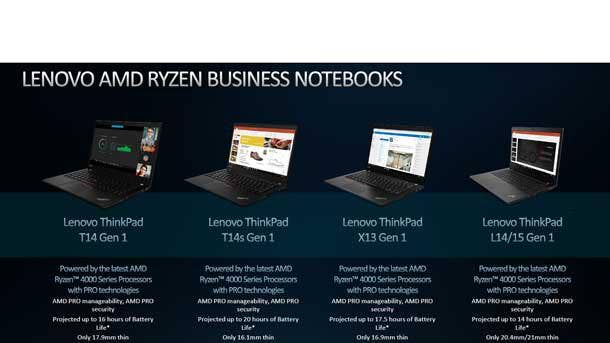
For customers that have switched from Intel to AMD for business laptops in the past, what strategies worked from an AMD, OEM or channel partner perspective?
When customers get their hands on an AMD platform, we've seen very consistent results: they evaluate those systems, they integrate them into their environment, and they see that many of the historical concerns around AMD platforms, many of which, frankly, were missed, but some of which do have some legitimate basis in issues from years back.
But as customers get those systems, they integrate them into their environments, we see that adoption is high, customers are satisfied, it delivers the performance, the battery life, the feature set that they need. And frankly, we're continuing to work through a long lasting perception in the market that we don't have the products that are capable, but I think that absolutely, we have shown with the products that we've released over the last couple years and now coming this year that we have more than overcome some of those previous shortcomings in our product stack.
On the EPYC side, AMD has been to use big names to show that big companies are adopting and choosing competitive solutions. Does AMD have brand names or customer names that they're using to show as an example of companies or organizations adopting Ryzen Pro?
Certainly, we engage on a regular basis with many large enterprises — Fortune 100, Fortune 500 companies — and [we] have won deals there. We tend to keep that information a little bit more confidential just as a part of our partnership with those end customers. So it's not something that we typically share in a public manner.
If AMD has a high-winning streak with Ryzen Pro this year or the year after, will the company be able to supply the demand and not fall behind?
The answer is, yes, absolutely. We work very closely with our partners to make sure that we are planning our business together, that we've got the right processes in place to plan supply. And from an AMD perspective, we are very closely engaged with all of the partners throughout our supply chain to make sure that the capacity we need is in place to support our growing roadmap. So certainly that is a top priority for us, but very confident in our ability there.
When customers get these Ryzen Pro 4000 laptops, how long do you expect them to be using those for? What's the expected average lifespan of these laptops?
It really depends on the customer, but what we tend to see is an average of about three years of lifespan for many of these platforms. But it really depends on the individual customer and the use cases that they're trying to address within their organization. So case to case, it depends a little bit.
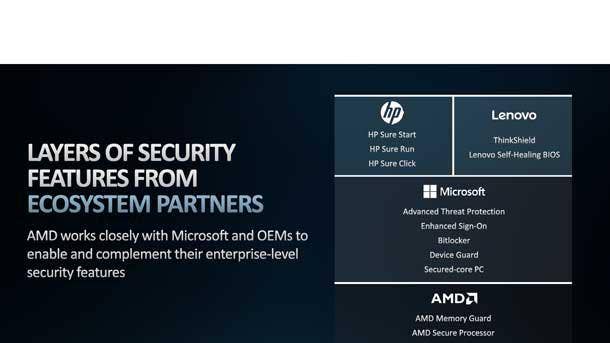
What does the Ryzen Pro roadmap look like in relation to the rest of the Ryzen product roadmap? And what is AMD's commitment to the Ryzen Pro platform in the long term?
I can't share a ton of details on that and our roadmap. What I will say is, if I take a step back and I look at this company, we have executed very strongly on our roadmap over the last few years. We continue to have a very strong pipeline in our roadmap moving forward. And that is core to everything that we're doing in this business. It continues to be a top priority for us.
And certainly the investments we're making, both on the engineering and the go-to-market side, are not investments that we're making for a one-time effort. Growing in the commercial business, continuing to deliver leadership capability in the commercial business, that is a top priority for us, and it's something that we're going to continue to focus on moving forward, well beyond 2020.
Does AMD have a feature roadmap for Ryzen Pro in place?
Yeah, absolutely. And as you look at our products, certainly these are complex products with a lot of different components or aspects that tie into it. There's the CPU core, there's graphics, there's our security roadmap, our manageability roadmap.
Certainly, as we look across all of those, we are very focused on making sure that, as we define the product roadmap overall and then work that in partnership with our OEMs, we're fully aligned as we work those roadmaps for years out into the future. So we do have a strong engineering execution engine there across all those areas and a strong plan that reaches well into the future.
To what extent does OEM and ISV feedback play a role in the development of Ryzen Pro?
They play a huge role. I cannot underestimate how important our partnerships are with our OEMs. One of the things that, frankly, we have taken a lot of pride in is trying to be the best partners possible with those OEMs. We engage with them early and often around our roadmap. We listen to their feedback. And frankly, nobody's perfect here, but we really do take their feedback seriously, and we integrate it back into our planning processes. And that's if you look at the OEM space.
I think it's true if you look at our partnership with Microsoft, which has been a been a big focus for us in the commercial client space as well. It is absolutely critical that as we're developing these products, we're not doing it in a silo. And so we have put a huge focus on driving that collaborative process around innovation and roadmaps in place with both our OEMs and Microsoft as our top partners, and then, of course, a number of secondary partners as well.
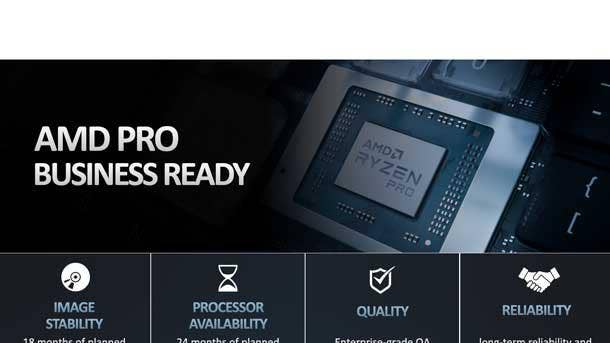
Is AMD working with ISVs on any kind of integrations or support for Ryzen Pro?
I can't talk to a lot of specific details there. But what I can say is, as we look across the ecosystem at different applications, at different tools and whatnot, yes absolutely, we build out those relationships and are continuing to grow those at a level that we have not historically had at the AMD side.
Can you explain what having 24 months of planned availability for Ryzen Pro processors means?
If you look at an end customer as an example, if there's a customer out there that wants to go purchase, let's just say 40,000 laptops for their employees, they're not usually going to buy all 40,000 of those on day one. What they'll usually do is they'll buy, you'll enter in an agreement there, and they will deploy those over the course of a year or six months or whatever their specific business conditions dictate. So it's important for our end customers to feel confident in the continuity of the products that they have. They don't want to go start deploying a product and then all of a sudden, the processor is end of life and they have to transition to some new platform. So it's really around making sure that the predictability is there around their planning capabilities, so they know exactly what they need to do for their business.
Do you think that the momentum the company has had with its other Zen 2 products is going to help with adoption of Ryzen Pro 4000?
Yeah, I do. I think as you look across our business, obviously these different products address different segments within the market, but as we continue to deliver and demonstrate leadership across these other segments, I think it absolutely helps us with our brand recognition and continue to build momentum there. It's key for us at AMD to make sure that all of our businesses are doing well, all of them are delivering the capabilities we expect, because you can use those successes as examples of how we can continue to help our customers grow in new parts of the market or growing parts of the market.
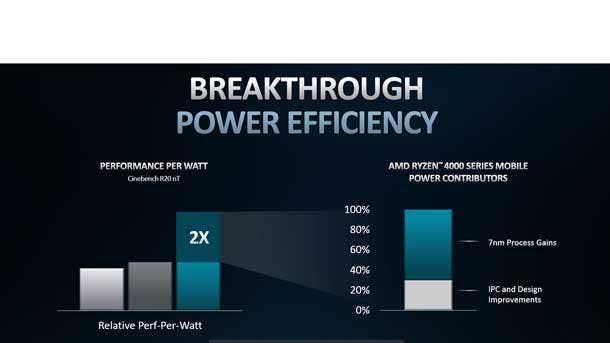
How do you get an OEM to adopt AMD's processors in more models over time?
It's a great question. I obviously can't share the details around the decision-making criteria or the processes that our OEM partners use. What I will say on our side is, especially in the commercial business, it's about delivering in a consistent and predictable manner over and over again, and you've seen us execute well on our roadmap. You've seen that we are delivering our products on time and hitting or exceeding the promises we have around the capabilities of our products. And we've now done that multiple generations in a row. I think that is foundational to building confidence with our OEM partners.
And then you pair that with these longer looking roadmap views around the capabilities, where we are continuing to invest heavily in this part of the business. And it gives our OEMs confidence in our ability to execute. I think that's step one. And that is foundational. And I think we've done a very good job in that space. The other piece, though, is actually delivering true leadership capability with our products and getting and continuing to grow that end user interest, demand and desire to use our products. And obviously all those pieces together allow us to continue to grow our portfolio.
Can you talk about why the doubling of the relative performance per watt in the Ryzen Pro 4000 series over the previous generation matters?
If you take a step back and you look at a platform, there are a lot of components in a notebook that consume power: the processor, components on the motherboard, the memory, the display, all of that. But the processor is obviously central to the entire thing operating, and it is central to managing the power of the system overall. And so as we look at our products, the ability for us to double the power efficiency of our of our [system-on-chip] as we transition to the Ryzen Pro 4000, that has a direct impact on reducing the overall power consumption of the platform, which in turn, then reduces the draw on the battery and it increases battery life. So you look at that 7nm technology that allows us to improve that power efficiency so aggressively translates to a better battery life experienced by an end user.
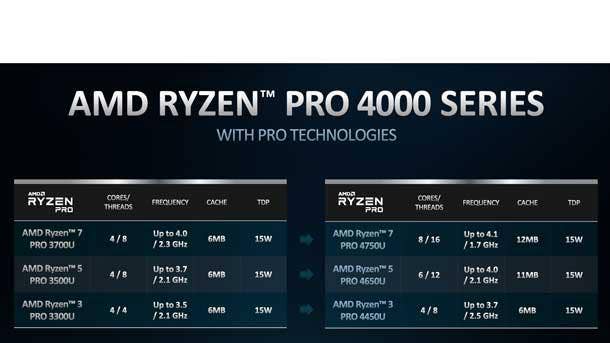
Who's going to benefit the most from those eight-core processors?
If you look across a number of use cases around business users, I think what you see is a lot of business users are heavily multitasking. They have a lot of different applications open. They're swapping back and forth. They might be on a Skype call at the same time that they're working on an Excel document at the same time that they're working on some PowerPoints. And so as you look at that multi-core, multi-thread, it really plays a strength around multitasking types of environments. The other thing that it does is it really positions us well as we move into the future and as more and more of these applications are optimized around multi-thread computing. I think you can see from some of the benchmarks in the slides that that we shared, the core and thread increase absolutely translates into performance benefits. The biggest value people are going to see is in a multitasking environment or heavy compute loads, where they really are going to see that eight cores and 16 threads stand out.
Does the lower frequency, when compared to Intel's vPro processors, put the Ryzen Pro 4000 processors at a disadvantage in that respect?
When you look at performance, there's a lot of different pieces that contribute to the performance aspect. What I would say is, it's a complicated equation. To answer your question, no, it does not leave our Ryzen Pro 4000 processes at a significant disadvantage in a way. And the reason is that frequency absolutely does contribute to performance. But equally to that is what we call IPC, which is the number of instructions that can be executed by the processor in every clock cycle. And it's really the combination of those two things that drive that. What you have with that Zen 2 core architecture is a substantial uplift in the IPC capabilities of our products gen-over-gen, which allows us to get more performance, even at a lower frequency. I would say that it's a little bit of a partial solution to only look at the frequency aspect of it without understanding that IPC uplift as well.
Does AMD plan to offer more SKUs in the Ryzen Pro 4000 series?
The plan right now, we've got three SKUs for Ryzen Pro, which is our Ryzen Pro 7, 5 and 3 SKUs. No plans to grow from that. I mean, frankly, we really believe that delivers the breadth of solutions that our customers need, from the top-end performance down to a more mainstream Ryzen 3 with four cores and eight threads that still delivers performance better than anything that was available last year. We also, though, do have our SMB platforms that use non-Pro [Ryzen SKUs].